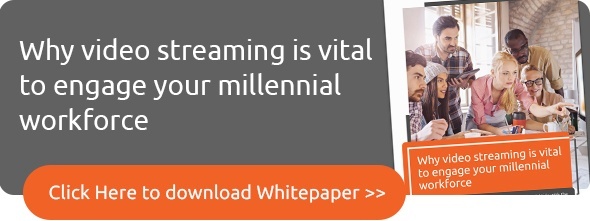Video is no longer considered an optional technology in the workplace, and enterprise video platforms are gaining immense popularity in organizations across all verticals. People prefer video as it engages them. According to a study it is estimated that the average person will spend 100 minutes every day watching online videos in 2021.
A Google survey showed that 6 out of 10 people prefer watching videos.
This blog discusses how you can set up an enterprise video platform and the 11 ways you can engage your employees.
With a surge of sophisticated video use cases across the enterprise, video management can no longer be left to disparate tools and insecure public channels like YouTube or Dropbox. The modern enterprise needs a consolidated enterprise video platform that single-handedly addresses all needs for video content capture, processing, storage, management, viewing, sharing, and archival – accessible to all stakeholder on all devices, locations and bandwidth conditions.
The benefit of using an enterprise video content management system is that allows you to stream video and engage your audiences in multiple ways. Here are 11 ways a modern enterprise video platform or video content management system can help engage employees in contemporary organizations:
1. Consolidated Portal:
In the absence of an enterprise video platform or video content management system, corporate video files are often saved to multiple disparate locations such as hard drives, network file share or a SharePoint site where it is impossible for others to locate or even playback due to frequent instances of incompatibility between user’s player and the video file type.
Additionally, lack of an enterprise video platform may pose security risks as employees often resort to using consumer tools like YouTube or Dropbox to externally save and share internal video content for the sake of convenience and efficiency.
Using a secure enterprise video platform, on the other hand, ensures all video collateral is centrally stored, processed and shared among all employees within one platform where it is easy to search for specific files and use from a mobile device without incurring any security lapses.
2. Multi-device Compatibility:
An enterprise video platform can effectively employ adaptive bitrate streaming to provide seamless video delivery and compatibility with all devices, including laptops, tablets, smartphones as well as modern wearable technologies.
3. Easily Searchable Content:
In a video content management system, all digital media is accessible with a simple and efficient search. Additionally, a modern enterprise video platform also provides automated transcription, which further refines indexing and search to the spoken word in a video, enabling superior search relevancy and efficiency across all media content residing on the video platform.
4. Interactivity Along with Videos:
Video is a powerful tool to interact with your audience. It is a highly effective form of content. You can interact in various ways, such as you can make introductory videos where every employee can give a short introduction. This will help newcomers to recognize who is who and what they do easily. Videos also encourage two-way communication. You can add quizzes, Q&A, surveys, etc. this will help you conduct an interactive session where every viewer is asked to participate.
5. Remote and Mobile Access:
An enterprise video platform gives users the ability to access the platform from any device, at any time, and in any location or bandwidth conditions. A video platform’s CDN-enabled technology optimizes external or remote delivery of video in the cloud or on-premises – allowing users smooth access to all live and on-demand video and other digital media while working from home, in public spaces, or even while working from remote locations.
6. Content Sharing for Employee Engagement:
It is very essential to have a secure platform where employees can share content with each other without any hassle. A platform where employees can upload and share videos inter-departmentally. This is encourages employees to engage with each other in a easier way. And is also highly convenient you can share or upload bulk of videos or files.
7. Employee Training and On-boarding:
A video is a great tool for onboarding and training purposes. The majority of time, these tasks require the same information such as someone new joins the team, want to know about their job role, switch roles, explain the company's policies, etc.
All this information can be captured in the video. And can be replayed whenever required. This frees up the speakers and delivers a consistent message so that everyone receives the same material.
8. Corporate Communication:
Enterprise video is the management’s most robust and scalable tool for executive communications and employee engagement. Managers can disseminate both live and on-demand video via an enterprise video platform to give employees a firsthand account of the company’s vision, mission, and performance while also creating a direct connection between senior business leaders and teams that may be scattered across the world.
For business leaders too, messaging packed in a video has a much more powerful impact that managers cannot create in emails or through top-down communication via management.
9. Media Capture From all Recording Devices:
Today, video can be created using a variety of recording devices such as mobile phones, webcam, digital camcorders, personal video recorders, wearable technologies, and more. An enterprise video platform captures and ingests video from all recording devices and provides compatibility with a large variety of video file formats, enabling the use of all types of video content, regardless of how it was recorded.
This not only enhances employee productivity by giving them the freedom to use any type or number of devices to record video but it also simplifies and, therefore, proliferates the overall use of video in the organization by removing any barriers to adoption.
Additionally, a video platform can also automatically capture and ingest recorded media from online meeting or video conferencing tools like Zoom, WebEx, Go-To-Meeting or Skype for Business.
10. Idea Sharing, Peer Feedback, and Collaboration:
In contemporary organizations, employee engagement can be improved with the help of enterprise video technologies that encourage sharing of ideas, voicing of opinions, and innovation derived from the collaboration.
A video platform can be utilized by employees to create videos comprising new ideas, industry knowledge, best practices, innovative market trends, and more, which could then be shared within the enterprise video platform with peers, coworkers or even managers who can provide feedback in the form of comments, likes, and even share it on other company social tools like Yammer or social media networks like Twitter or Facebook.
This would give employees instant and ongoing feedback in real-time while also adding to the collaborative element of their job. Additionally, employee-generated video content gives the workforce a voice in the overall communication efforts in a company, and the resulting engagement could work wonders to drive success in all areas of business by boosting employee performance across the board.
11. BYOD-Enablement:
Enterprise video platforms can be enabled for BYOD (Bring Your Own Device) technologies in the cloud and on-premises installations to allow users to securely access all video and digital media assets from any permissible device, providing the ultimate accessibility and flexibility of multi-device video upload, search, viewing, sharing, and other capabilities.
12. Android and iOS Mobile App:
An enterprise video platform mobile app could be hugely effective in simplifying and facilitating its use by the employees, just like the other apps they use on a regular basis.
A video platform can be accessed through Android and iOS apps that provide users access to all digital media content on their smartphones, allowing them to create, share and manage live or on-demand video and other media directly from the app.
A video platform app also facilitates offline video viewing by offering an option of offline media downloading, storage, and viewing within the app.
VIDIZMO, a Gartner recognized enterprise video platform and streaming video solution, offers a comprehensive video platform for securely streaming live and on-demand videos on any device, be it phone, laptop, etc.
VIDIZMO provides a platform that fulfills all the points mentioned above and much more. VIDIZMO enables users to host and manage all video content with enhancing search capabilities; that allows you to search within videos through ASR, OCR, objects, spoken words, etc. You can also make live and on-demand videos interactive by adding quizzes, surveys, Q&A, handouts, etc.
Moreover, VIDIZMO provides detailed analytics to see how people engage with your videos that include geo-mapping, you can see how many customers watched a video, which parts were the most-watched, what days your views peaked, and more.
Additionally, VIDIZMO leverages AI and cloud technology from leading cloud providers such as Microsoft and AWS.
VIDIMZO offers flexible deployment you can either deploy on-premise, cloud or hybrid. For more information, visit our website or contact us to request VIDIZMO's free 14-day trial.
Posted by Rabeea Tahir
Rabea Tahir is Technology Content Strategist at VIDIZMO which is a Gartner recognized enterprise video content management system, to stream live/on-demand media to both internal and external audiences, on-premise, Azure or AWS cloud. VIDIZMO solutions are used by enterprises, government, local, state government, healthcare, law enforcement agencies, justice, public safety, manufacturing, financial & banking industry.




